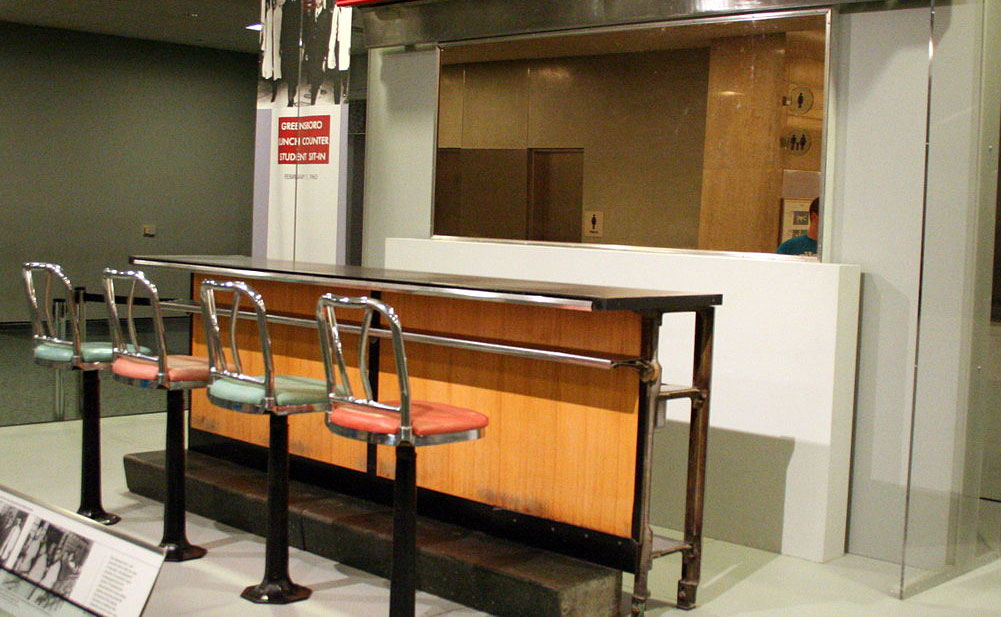
February 1, 2020; Smithsonian Magazine and Charlotte Business Journal
On Monday, February 1, 1960, four young black men entered the F. W. Woolworth store in Greensboro, North Carolina, sitting down at a lunch counter at the department store. The choice of the location was no accident. At the time, Woolworth’s was among the nation’s largest department store chains, operating nearly 2,500 stores in North America.
The four men—Joseph McNeil, Franklin McCain, David Richmond and Jibreel Khazan—all four first-year college students at North Carolina A&T, a local historically black college (and today the country’s largest), risked arrest and quite possibly injury (or worse) at the hands of the police by sitting at a whites-only lunch counter to order coffee after buying store items. They quickly became known as the Greensboro Four.
As Christopher Wilson details in Smithsonian Magazine:
The four students politely asked for service and were refused. The white waiter suggested they go to the “stand-up counter” and take their order to go, which was the policy for black customers. The activists begged to differ as they pulled out their receipts and told her they disagreed with her. “You do serve us here, you’ve served us already, and we can prove it. We’ve got receipts. We bought all these things here and we just want to be served,” McCain remembered saying.
The Greensboro sit-in, of course, wasn’t unique. The tactic, for instance, borrowed from the Flint, Michigan sit-down strike of 1936–37. Wilson notes that in 1957 seven Blacks staged a sit-in at the segregated Royal Ice Cream Parlor in Durham, North Carolina.
Sign up for our free newsletters
Subscribe to NPQ's newsletters to have our top stories delivered directly to your inbox.
By signing up, you agree to our privacy policy and terms of use, and to receive messages from NPQ and our partners.
One ingredient was publicity. “Only one photograph was taken of the activists from the first day at Woolworth’s, but that was enough to gain some exposure in the press,” Wilson explains. “By February 4, the campaign had grown to hundreds of students.”
A second key element was planning, which, Wilson notes, “occurred more than a year earlier and 400 miles away in Nashville, Tennessee.” The planning even included “test sit-ins” in downtown Nashville during the fall of 1959.
A third lesson is the importance of building a sense of political efficacy—which NPQ’s Cyndi Suarez recently labeled a state of power. Ultimately, management at Woolworth’s agreed to integrate the lunch counter in Greensboro on July 25, 1960, as Black kitchen workers Geneva Tisdale, Susie Morrison, and Aretha Jones removed their Woolworth’s aprons and became the first African Americans to be served. But civil rights leader Diane Nash tells Wilson that “the biggest effect of this campaign was the change it produced in the activists themselves, who began to understand their own power and the power of nonviolent direct action.”
A fourth lesson is the need for decentralized mass action. Nash observes that a focus on heroes or iconic moments like the Greensboro Four can hide from us the many thousands who were involved, without which the Greensboro Four would’ve failed. Nash tells Wilson that if you focus on leaders, “You’ll think, ‘I wish we had a great leader.’ If you understood it as a people’s movement, you’d ask ‘what can I do’ rather than ‘I wish someone would do something.’”
Certainly, today, despite the gains achieved by the Civil Rights Movement in the 1960s, the need for social movement remains as great as ever. Writing about the sit-ins in the Charlotte Business Observer, John Joyce and Jane Little observe, “According to the best data available, having adjusted for inflation, the gap between white and black household incomes is greater today than it was in 1970, a decade after the sit-in. The median family income for the total population of Guilford County in 1970, expressed in today’s dollars, would have been $64,598. For Black families it would have been $43,027.” By contrast, according to 2017 Guildford County data, the median white family income in 2017 was $63,749, compared to $38,173 for Black families.
Shirley Frye, who participated in the movement in Greensboro 60 years ago, tells Joyce and Little, “I look at life as I do a wedding band; there is no beginning and no ending. You have to continue working on it. And I think that is where we are in Greensboro.”—Steve Dubb












